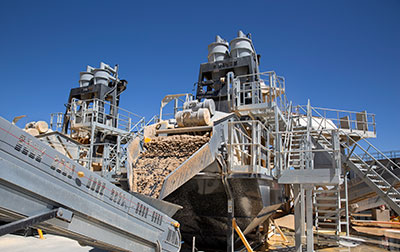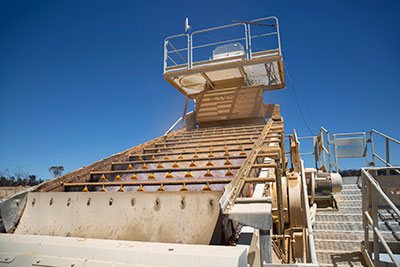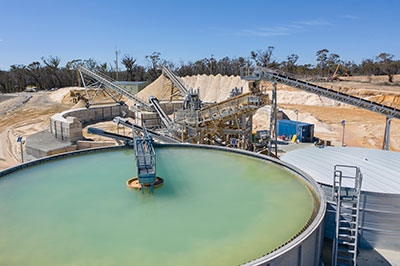Project Summary
This wash plant based near Sydney, Australia, has been designed, manufactured and installed by Terex Washing Systems to wash and classify up to 300tph of construction sand. Clarence Sands aimed to produce premium construction sand from their sandstone deposit to serve the greater Sydney area. In order to meet the level of through put requested by the customer Terex Washing Systems developed a new rinsing screener to allow for increased tonnage per hour.
The Clarence Sands wash plant is made up of a H30 Feeder, a 20x8 2 Deck Rinsing Screener, two FM 200C Sand Recovery Units, a Flocculant Dosing Unit, a Rake Thickener Tank and a number of stacking conveyors. The large through-put and stockpile capacity resulted in the installation of two 26-metre radial stockpiling conveyors.
Terex Washing Systems was able to provide an end to end solution for this project. This resulted in a finely tuned system with individual parts being fully integrated. Learn more about this project below and feel free to contact us with any queries.
H30 Feeder | 2 Deck Rinsing Screen |
Sand Cleaning Plants | Water Management System

Featured Products
Cleaning Construction Sand
Terex Washing Systems have recently commissioned a sand washing plant for Clarence Sands. This  newly established operation is now one of the premium sand quarries in Sydney, Australia. The sandstone deposit located in the Blue Mountains produces premium quality construction sand that’s washed and classified using a state-of-the-art Terex Washing Systems wash plant. The bespoke design can produce up to 300 tonnes of quality sand per hour and recycles roughly 95% of the water used during the washing process.
newly established operation is now one of the premium sand quarries in Sydney, Australia. The sandstone deposit located in the Blue Mountains produces premium quality construction sand that’s washed and classified using a state-of-the-art Terex Washing Systems wash plant. The bespoke design can produce up to 300 tonnes of quality sand per hour and recycles roughly 95% of the water used during the washing process.
The wash plant features a H30 Feeder that receives the raw sandstone feed material and distributes it evenly on the main conveyor. At this point any stones or rock that are larger than 100mm are removed from the feed material due to the grid covering the feeder. The H30 Feeder features a hydraulic tipping grid that can be controlled from the cab so that any material stuck on the bars can be cleared.
Tailor Made Sand Screening
 With the sand distributed evenly on the main conveyor it makes its way up to the modular 20x8 2 Deck Rinser Screen. This screen is the first of its kind and has been designed specifically to handle the tonnage needed for this operation. A total of
15 spray bars give the material an initial rinse as the vibrating screener shakes the sand and stone down through the polyurethane decks as it is classified by size. The polyurethane decks have a much longer ware life than that of metal decks.
Any larger aggregates can pass through the screen onto aggregate and oversize conveyors where they are stockpiled as products for sale.
With the sand distributed evenly on the main conveyor it makes its way up to the modular 20x8 2 Deck Rinser Screen. This screen is the first of its kind and has been designed specifically to handle the tonnage needed for this operation. A total of
15 spray bars give the material an initial rinse as the vibrating screener shakes the sand and stone down through the polyurethane decks as it is classified by size. The polyurethane decks have a much longer ware life than that of metal decks.
Any larger aggregates can pass through the screen onto aggregate and oversize conveyors where they are stockpiled as products for sale.
Any sand, silt, clay or other fine impurities that were present within the feed material is washed to the split catchbox of the screener where the material is gravity fed into one of two FM 200C Sand Plants. Each sand plant receives a separate split, one Coarse Sand and on Fine Sand. The hydrocyclones use centrifugal force to separate the sand from the silt and clay so that it can be transferred onto the high frequency dewatering screens. These dewatering screens remove the remaining water within the sand so that only 10-15% of water is left. The sand that is now up to spec is then transferred onto a 26-metre radial stacking conveyor that offers a large stockpile capacity, which really suits the needs of the customer. These conveyors have been fitted with walkways so that servicing is made easier.
Water Recycling
The water that, up until this point, has been used to initially rinse the feed material, wash the sand  within the FM 200C and has been recovered from the dewatering screen is pumped into the 17-metre rake thickener tank. The rake thickener allows
the silt and clay particles within the sludge to settle at the bottom of the tank, while the clean water weirs over the edge to be re-used. The integral scrapers aid transportation of material from the outskirts of the tank to the outlet, thus
accelerating the removal of sludge from the thickener.
within the FM 200C and has been recovered from the dewatering screen is pumped into the 17-metre rake thickener tank. The rake thickener allows
the silt and clay particles within the sludge to settle at the bottom of the tank, while the clean water weirs over the edge to be re-used. The integral scrapers aid transportation of material from the outskirts of the tank to the outlet, thus
accelerating the removal of sludge from the thickener.
This process is sped up with the use of a Flocculant Dossing Unit, which dosses the sludge on its way to the rake thickener. The flocculant that is added to the sludge causes the waste particles to bind together, creating a particle with a larger mass, which then sinks to the base of the tank faster. Dossing the sludge with flocculant dramatically increased the speed at which the clean water can be recycled back into the wash plant.
A wash plant can’t do its job without water, which can be a difficult resource to manage in Australia. Terex Washing Systems advised the customer of the need for a robust water management system that would be both environmentally friendly and save on running costs. Neil Rooney, Engineering Manager for Terex Washing Systems, explains that, “over the last number of years we at Terex Washing Systems have developed our water management product range to the point that we’re confident we can meet the needs of any application”. He continues, “The Clarence Sands wash plant is a good example of how an efficient water management system can take an operation to the next level. Settling ponds are eliminated and the wash plant can run continuously without the need to stop and dig those ponds out”.
A modern company needs a truly modern wash plant and Terex Washing Systems have achieved this through close dialogue with the customer. Clarence Sands have the tools needed to produce premium grade construction sand for the greater Sydney area.
Contact us using the link below to find out more on the this washing systems or to discuss your specific washing requirements.
Watch Video




